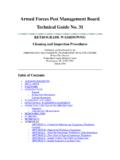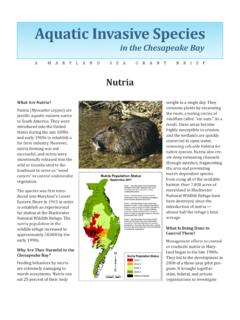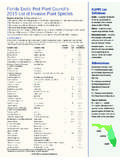Transcription of Sacred Ibis: a new invasive species in Europe
1 Sacred ibis Threskiornis aethiopicusis closelyrelated to both Black-headed ibis T. melano-cephalus(from the Indian subcontinent) andAustralian White ibis T. molucca(which breedsin Australia, New Guinea and some nearbyislands) to the point that they are sometimestreated as one species , T. aethiopicus. However,they are generally regarded as three distinctspecies forming a superspecies (egdel Hoyo ). The nominate form of Sacred ibis (T. ) is widespread in sub-SaharanAfrica, while different subspecies breed onMadagascar (T.)
2 A. bernieri) and Aldabra (T. , although this is considered by some asinseparable from bernieri). The species iscommon to very common within its main Africanrange, where its population is considered to bestable at an estimated 200,000 to 450,000 indi-viduals (Delany & Scott 2002). North of itspresent range, the species was common inEgypt until the beginning of the 19th century,when it died out for unknown reasons (del Hoyoet ). Also, a very small and decliningpopulation occurs in the marshes of southernIraq (Delany & Scott 2002).
3 There is no evidence that the species everoccurred in the wild in Europe egno fossilremains have ever been found in Europe (Maurer-Chauvir 1993). Sacred Ibises have,however, escaped from captivity and been seenin the wild in Europe since the 19th century, egin Italy (Andreotti et ), but this remaineda rare event until about the 1970s when itbecame fashionable to breed free-flying groupsof ibises in zoological gardens. This led to aregular flow of escapes, which in turn led to theestablishment of breeding pairs in the wild, andbreeding populations have now become estab-lished in Spain, Italy and France, as well as onthe Canary Islands.
4 Stray birds have also beenreported in other countries. This addition to the European avifauna hasbeen welcomed by some, due to the tamenessand attractiveness of the birds, as well as theaura surrounding the species , which has beenvenerated since the time of the Pharaohs (and isalso the emblem of the BOU!). Its feeding habits,however, are cause for real concern. In someareas, it is proving to be a serious predator ofother bird species of conservation concern. Herewe report on the current European status ofSacred ibis and on its potential conflicts withconservation ibis : a new invasive species in EuropePierre Y sou and Philippe ClergeauPlate 1.
5 Sacred ibis Threskiornis aethiopicuscolony, Loire Estuary, Loire-Atlantique, France, June 2005 (Pierre Y sou). 10-Aug-06 12:30 PM Page 517518 Breeding in SpainAccording to Jordi Clavell, co-ordinator of theexotic species study group within SEO/BirdLifeSpain (pers. comm.), the species is held in anumber of zoos in Spain, from where escapeshave occurred in various regions from Galicia,Asturias and Cantabria in the north to theGuadalquivir Marismas of Andalusia in thesouth. In Barcelona (Catalonia), birds initiallybreeding in the zoo escaped to settle in a nearbypublic park, where breeding first occurred in1974.
6 There were up to 18 individuals there inthe early 1980s, but this reduced to 4 6 pairs inthe 1990s, and the last breeding occurred in2001. The species is still kept in the zoo, butthe birds are now under control. When breedingoutside the zoo, these birds used to visit nearbywetland areas, including the Llobregat and EbroDeltas. Sacred Ibises are no longer known tobreed in the wild in the area, or to escape fromthe zoo, but occasional birds continue to occurin the wetlands of northern Catalonia, and it isconsidered that these probably come from theFrench population (see below).
7 In recent years, up to five birds have beenregularly seen at the Guadalhorce rivermouth inMalaga and immatures have joined the adultsinitially present, suggesting that breeding mighthave occurred in the in the Canary IslandsThe first sighting in the wild in the CanaryIslands dates back to 1989 and there are nowrecords for Tenerife, Gran Canaria, Lanzaroteand Fueteventura. However, the species is keptin zoos on all four of these islands, and at leastsome of these birds are known to be free-flying,so all records are presumed to be escapes.
8 Upto about five pairs have been breeding in thewild in the vicinities of the zoos on Lanzaroteand Fuerteventura since at least 1997 (JuanAntonio Lorenzo in litt.).Breeding in ItalyThe species has been breeding in the wild inItaly, in the upper Po valley, Piemonte, since1989. There were 26 pairs and about 100 indi-viduals in 2000. In 2003, breeding was observedat another site in the same area, with possiblyup to 25-30 pairs, and a few more pairs werefound at a third colony in 2004. Unfortunately,there have been neither co-ordinated counts ofthe breeding sites nor updated estimates of thepopulation size since 2000 (Andreotti et , Giovanni Boano and Nicola Baccetti ).
9 Plate 2. Sacred Ibises Threskiornis aethiopicus, Loire Estuary, Loire-Atlantique, France, June 2005 (Jean-Luc Potiron). Sacred Ibises breed colonially, with the nests very close together and the young tended in a cr che. 10-Aug-06 12:30 PM Page 518519 Breeding in western FranceFrom 20 Sacred Ibises imported from Kenya infour deliveries during 1975-1980, and thensupplemented with 10 more birds from anotherFrench zoo in 1987, a breeding colony soonbecame established at Branf r ZoologicalGardens in southern Brittany. There were 150pairs in the zoo by 1990.
10 The young wereallowed to fly free and many quickly wanderedaway, mostly visiting nearby wetlands, but withsome travelling hundreds of kilometres alongthe French Atlantic coast (Fr mont 1995, Y sou2005). Breeding in the wild in France stemmedfrom these birds and was first noted in 1993 atboth Golfe du Morbihan, 25km from the intro-duction source (Fr mont 1995; although it issuspected that breeding began a few yearsearlier, Y sou 2005) and Lac de Grand-Lieu,70km away (following an attempt there in 1991,Marion & Marion 1994).







